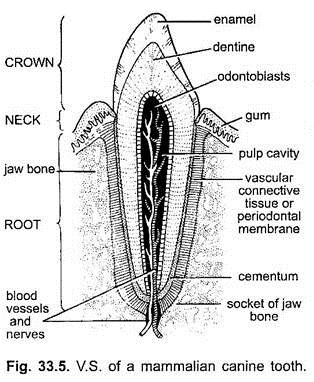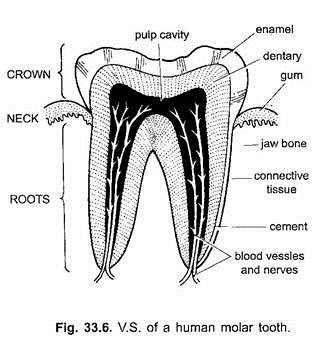Structure of teeth is similar in all the vertebrates. A typical mammalian tooth is differentiated into 3 parts- crown, neck and root. Crown is the visible part of the tooth projecting out from the gum and out of the jaw bone.
Root is the basal part, embedded in a socket or alveolus of the jaw bone. The junction of crown and root is called the neck. A tooth is made largely of a hard dermal bony substance the dentine (ivory). The crown is externally covered by a thin very hard and shining layer of enamel. Enamel is the hardest substance in the body of vertebrates. The root of tooth is surrounded and fixed to the jaw bone by a layer of cement and a vascular periodontial membrane.
It is made of strong connective tissue fibres (Sharpey’s fibres) running from cement to bone. Inside the tooth is narrow pulp cavity. It contains connective tissue or pulp with blood vessels and nerves. The blood vessels and nerves enter the pulp cavity through its opening present at the apex of the root. Lining the pulp cavity is a layer of bone cells, the odontoblasts, which send fine protoplasmic processes into canaliculi of dentine.
The main mass of the tooth is formed of a very hard substance, called dentine, which encloses the pulp cavity. The dentine is covered over by enamel in the crown region and by cement in the root region. Further, the attachment of tooth on the jaw bones is strengthened by the gum. In the incisors of lagomorphs, rodents and elephants, the pulp cavity remains open basally so that these teeth continue to grow throughout life and are termed open-rooted.
ADVERTISEMENTS:
In the majority of mammals, including man, the basal aperture of pulp cavity becomes closed at a certain age so that nourishment stops and further growth ceases. Such teeth are termed close-rooted.

